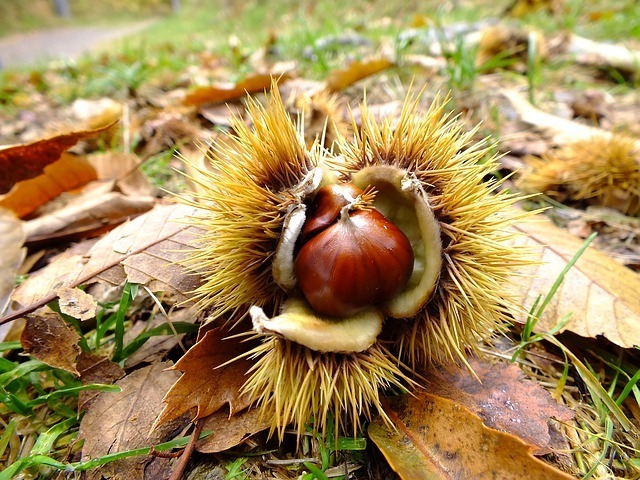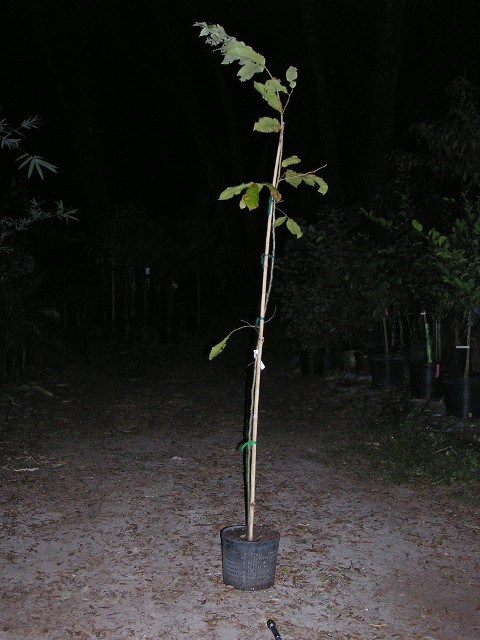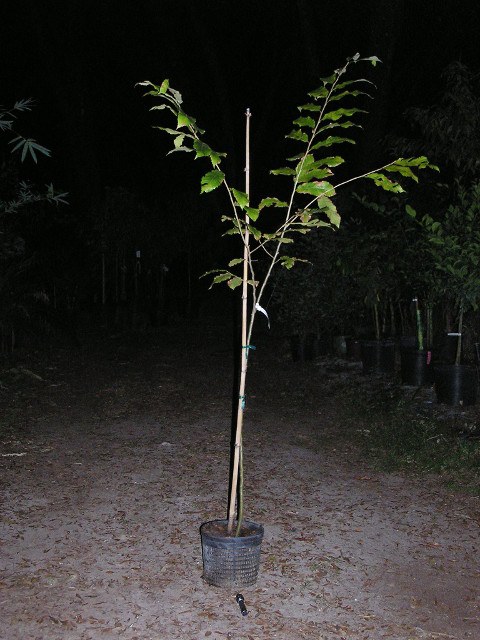Nothing says "Thanksgiving"
quite like Chestnuts!
Native American Chestnut trees were nearly wiped out by fungal blight in the early 20th century, but thanks to much research into resistant hybrids, the American Chestnut tree is making a hardy comeback.
Dr. Robert T. Dunstan, a plant breeder in NC, pioneered much of the research. He developed many crosses between the imported Chinese Chestnut & the native American Chestnuts. His work is a trademarked name brand under which many of those same hybrids are still marketed. Read more here.
These new American-Chinese hybrids are superior in size, nut quality, and production to most any American or Chinese chestnuts. They are superior in taste to any European chestnuts. And they are more disease resistant than the original native American chestnut, though a few native survivors are being found in recent years.
WHAT WE RECOMMEND
There are several excellent varieties of previously patented hybrids that are hardy in this area of Florida: Willamette, Carpenter, Revival, and Auburn Leader are a few.
We favor the Willamette for its super sized nuts and high genetic resistance to the chestnut bark blight, and the Revival or the Carpenter as close seconds for pollination.

Looking more like a martian than a piece of food,
here's a newly ripe chestnut still lying in the husk
QUICK FACTS:
- Chestnuts are fast growing deciduous trees (lose their leaves in the winter.) For zones 4-9
- Requires a minimum 250 chill hours
- Prefer slightly acidic soil & consistent watering.
- Maximum height: 100' tall
- Plant a minimum of 40' apart to give room to spread, but a maximum of 100' for pollination.
- Pollination: takes 2 plants: need either any 2 seedlings or 2 different grafted cultivars, or any one seedling and any one grafted cultivar.
- Blooms late spring: nuts ripen Sept / Oct.
- Produces chestnuts in 3-5 yrs from seed.
WILLAMETTE
Genetics
According to the US patent office, "Willamette" is a medium sized hybrid derived from a cross between a hardy native seedling (from Ohio), and a composite tree of 3 Chinese varieties: Kuling, Meilling and Nanking, in 1953 in NC. After 3 generations of cross-breeding, the Williamette is one of many results.
Willamette is propagated both by grafts and by open-pollination seedlings -- not grafted. Read more here and here.

CARPENTER
Another Chinese-American hybrid from the same breeding program as the Willamette, 'Carpenter' is very well adapted to the South.
'Carpenter' is a vigorous growing tree with a strong upright habit that produces 20-25 tasty nuts per pound.
It pollinates well with any of the other hybrids -- Willamette or Revival -- or the improved Chinese variety, Auburn Leader.
Growth
Growth habit of the Willamette is more like the native American chestnut. Trees are quite vigorous, and hardy, attaining 25' hgt and 18' spread by 12 yrs of age on average.
Trees have a very upright, widely spreading form, with large, glossy dark green leaves. Williamette reaches 40-50' at maturity, with a total spread of about 30'. It flowers late but profusely in the spring, after leaf-out.
Willamette is a dependable, prolific bearer of extremely large, dark chocolate brown, very sweet and easy to peel nuts. Nuts ripen in mid-September, and release easily from the burrs, making them easy to harvest.
"The kernel is a light white color and excellent in taste, being very sweet, even raw and uncured, and is delicious when steamed or roasted." (from patent description)
Willamette trees produce an average of just 18-22 nuts per pound, rivalling the 'Colossal' at 14-18 nuts per pound. (Colossal is primarily promoted by propagators in CA and is not readily available in FL.) Willamette nuts are extremely large: 1.5"x1.25".
REVIVAL
Out of the same breeding program as the Willamette, Revival is another delicious chestnut hybrid available to us in North & Central FL. Flavor of the Revival is hard to distinguish from the Williamette.
In comparison, Revival produces a smaller nut at 24-32 nuts per pound, and are a little lighter in color, making it easy to distinguish from the Willamette. Many of the Chinese varieties produce an even smaller nut at 32-40 nuts per pound.
Growth
Revival tends to be a shorter, bushier tree than the Willamette, though the Willamette shows the most fungal resistance in this area.

CULTIVATION
Chestnut trees need cross pollination from a second tree to produce a good crop of nuts.
Grafted trees need a second (different) cultivar to pollinate. Because seedling trees are each genetically different, they should readily pollinate each other but will exhibit some variances in nut sizes and ripening times. Grafted trees are generally preferred for commercial groves, but totally unnecessary for the home orchard or for wildlife plantings.
That said, chestnut grafting research is still in its infancy and grafts can fail after a few years for unknown reasons of incompatibility.
GROWTH
Chestnut trees are fast growing and can reach heights of 100' or more with time. They should be planted a minimum of 40' apart. Maximum distance for proper pollination is 100'.
Consistant irrigation is essential, though they like good drainage. Chestnuts grown in clay soils must have good drainage as they do not like to have their feet standing in water for even short periods. Chestnuts prefer slightly acidic soil at 5.5-6.5pH, and do not tolerate alkalinity at all.
Chestnuts start bearing nuts in only 3-5 years from seed. They produce 2000-4000lbs of nuts per acre. Nuts ripen in September and October.

Chestnut blossoms
PESTS
The worst pest now affecting chestnuts in the US is the presence of chestnut weevils. They lay eggs in the ripening nuts, nuts fall to the ground, eggs hatch, larvae eat their way out of the nuts and then burrow into the ground.
YEA! FOR PERMACULTURE!
The best organic control that has been proven reasonably effective, is to use chickens or Guinea fowl in the orchard to eat the larvae. After several years of this control, few weevils remain! Read more here.

4g chestnut tree: 8' tall
some young trees will branch more quickly:

4g chestnut tree: 7' tall

OTHER USES
Chestnuts are often planted in food plots to attract deer, but must be protected as young plants until established. Plastic tubes around the trunks or even tree shelters may be necessary.
Deer reportedly choose chestnut 100:1 over acorns.
Availability for Fall 2024 - Spring 2025:
7G -- Carpenter only; no 3G
Williamette & Revival are out of stock until further notice:
click the grey option line to order the 7g size only!







